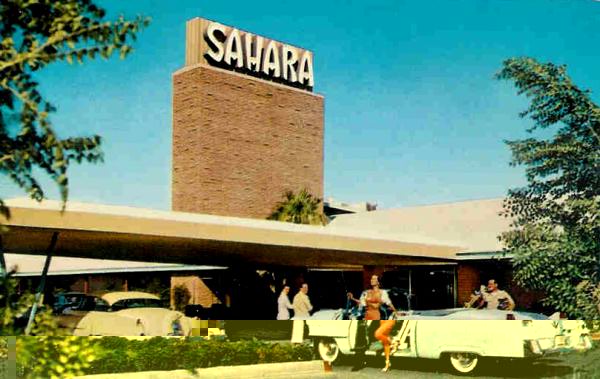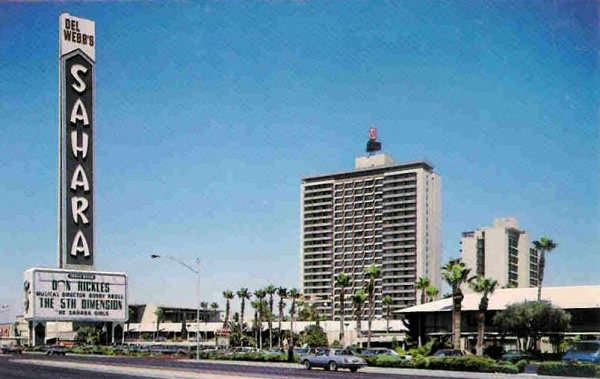
Photo from the Mark Englebretson Collection

Photo from the Mark Englebretson Collection
| Sahara |
| 2535 Las Vegas Blvd South |
| est. 1952 |
 Photo from the Mark Englebretson Collection |
 Photo from the Mark Englebretson Collection |
The Sahara
The sixth resort on the Strip CLUB BINGO On July 24, 1947, the Club Bingo opened on the corner of Highway 91 and San Francisco Avenue, across the highway from the El Rancho Vegas. Milton Prell built the club on land that was owned by Mel D. Close, Sr. The sign on the outside of the building featured a large neon bingo card, and the inside of the club featured a 300-seat bingo parlor. In addition, the club was licensed for slots, blackjack, craps and roulette. On opening night Club Bingo raffled off a brand new Cadillac, the lucky winner was a gentleman who owned a hamburger stand. In the evening, Las Vegans often ran into friends and neighbors while enjoying drinks served by the friendly bartenders at the club. In the morning, the club served the best 49-cent breakfast around. It wasn’t long before Prell added the Bonanza Room, for entertainment and dancing. What Club Bingo didn’t have was a hotel. THE SAHARA In 1952, Mel Close sold the land under Club Bingo to Milton Prell, Al Winter, and a group of investors from Portland, Oregon. Deciding that a hotel was needed, the group solicited backing from Texas financier A. Pollard Simon. Finding that their financing was still short, the group contacted contractor Del Webb, who agreed to build the new hotel at, or near, cost in exchange for 20% interest. On October 7, 1952, the Sahara opened. The theme of the property was African, with statues of camels in front of the hotel. The Congo Room was decorated with statues of Arabs; The Caravan Room restaurant and the Casbar Lounge overlooked the swimming pool. The lobby and casino were in the front of the main building, with restaurants in the rear overlooking the two-story room wings. The wings held 206 rooms, each with a balcony or patio. Prell dubbed his new creation “The Jewel in the Desert”, perhaps in tribute to his previous occupation—he was a jeweler. Dining and Entertainment The Congo Room was promoted as “Breathtaking… Spectacular… Unique… artistically designed as the nation’s most beautiful room”. Booths and tables were triple-tiered, and positioned to provide an unobstructed view of the elaborate stage from every seat. The Congo Room offered an international selection of menus, with each menu giving a wide variety of selections to satisfy the food whims of the most discriminating diner. The Caravan Room was surrounded by large picture windows, which overlooked Las Vegas’ largest swimming pool, and the Garden of Allah, with its lush vegetation. The heated pool, holding over 200,000 gallons of water, was built to meet official Olympic specifications. The Caravan room was open, for delicious meals, from early morning until midnight. The Casbar Lounge (“we know it’s spelled wrong”) was a cocktail lounge that served the finest liquors in an atmosphere of romance, soft lights, and delightful musical entertainment. That’s Entertainment The Riviera, in Fort Lee, New Jersey, was a swank club with illegal gambling upstairs. When World War II started, the club closed. Bill Miller bought it in 1945, renamed it “Bill Miller’s Riviera”, and reopened without gambling. After struggling for the first year, the club became successful. According to Miller, Sinatra played there, as did Dean Martin, Joey Bishop, Jerry Lewis, and Sammy Davis Jr. with the Will Mastin Trio. In 1953 Bill Miller’s Riviera was closed, and a highway was built through the property. Milton Prell called Bill Miller and invited him to join the Sahara group. Miller bought a 10% interest in the property and was named entertainment director. The first act that he booked at the Sahara was Ray Bolger, best known as the scarecrow in The Wizard of Oz. Bolger was popular as a dancer, but he didn’t have a nightclub act. Miller put together a variety show, with Bolger acting as emcee and performing his dance routines between the other acts. Louis Prima and Keely Smith In 1954 Miller received a call from Louis Prima, a gravel-voiced vocalist and trumpeter whose arrangements combined swing, Dixieland jazz, Italian folk songs and comedy. Louis’ wife, Keely Smith, was pregnant, they had no job and no prospects, and they were broke. Could Miller use them and their small group? Miller said he could use them…in the lounge. When Louis hesitated, Miller assured him that they would make more money than they ever had before. Louis asked when they had to be there, “In six days” replied Miller. While Keely packed, Louis contacted the members of their group. They left New York in a caravan of cars. Being pregnant, Keely got sick from time to time, and the entire caravan would come to a stop ‘til she recovered. They finally reached Las Vegas. On November 24, 1954, Prima and Smith opened in the lounge at the Sahara. There were virtually no lights on the stage, just a tiny spotlight for the performer to stand under. The service bar for the waitresses was right in front of the stage. Waitresses yelling out drink orders in the middle of a number often interrupted the show. The song would stop, Prima would ask the waitress if she was done then, receiving an affirmative answer, the song would pick up right where it left off. After a few days of that, Prima told Milton Prell that it just wasn’t going to work. The next day the service bar was moved to the far end of the bar, away from the stage. In 1954 the lounge was wide open. A man gambling in the casino could look over and see his wife in the lounge, while she enjoyed a drink and listened to a few songs. Prima and Smith, however, didn’t just play music; they put on a show. According to Bill Miller “…there was no one, ever, in the history of show business, that did the business that this man [Louis Prima] did from midnight until 6 in the morning. You could not get into that club.” Keely Smith says the crowds were so large that the room had to be enclosed. Drapes were put up to help muffle the sound, but the show was still louder than the pit bosses, dice tables and slot machines. Eventually the lounge was enclosed with glass. They did five shows a night, from midnight to 6 a.m., eventually out-drawing the main showroom. Their engagement at the Sahara lasted for six years. As of 1999, Keely Smith was still performing, and a portion of her show was dedicated to Louis Prima. Expansions As the Sahara gained in popularity, it needed to add more rooms to accommodate all the guests. The Bank of Las Vegas opened in 1954, and shortly after that banker E. Parry Thomas was assigned to work there. Parry had the vision to see what Las Vegas was becoming, and knew that he and the bank could be a part of the growth. In 1955, Parry Thomas and the Bank of Las Vegas loaned the Sahara $750,000 for additional rooms and improvements. That was the first time a bank loaned money to a casino. Prior to that, the casino owners had to rely on whatever cash they could come up with, either privately or by taking in partners who often had connections to organized crime. In the mid-1950’s, Las Vegas finally began building upward, and in 1959 the Sahara added a 14-story tower, with 200 rooms. The tower was constructed on the far side of the swimming pool, and was patterned with windows and balconies. There was a digital time and temperature board on top of the tower, capped with a stylized “S”. The expansion also included a convention center and a 127-foot vertical roadside sign, by YESCO. In 1961 Milton Prell sold the Sahara to Del Webb, who arranged a merger between his construction company and the Sahara-Nevada Corporation. The merger also included Prell’s downtown Mint and Lucky Strike Clubs. Prell continued to operate the Sahara until 1964. Del Webb continued an aggressive expansion plan, adding a 24-story skyscraper (at the time, the tallest in the state) with 400 rooms, which brought the Sahara to over 1000 rooms. Webb also added a 44,000 square foot convention facility and a parking lot with spaces for over 3000 cars. Paul and Sue Lowden purchased the Sahara from Webb in 1982, and in 1988 added a 26-story tower, expanded the casino, and added a new race and sports book. In 1995, Bill Bennett bought the Sahara from the Lowdens for $193 million. Bennett immediately began a $100 million renovation project, which included remodeling the Casbar Lounge and 1,720 hotel rooms. After Bennett passed away the Sahara was put up for sale, in 2007 it was sold to SBE Entertainment Group and Stockbridge Real Estate Funds. The Telethon While not as well known as the Desert Inn, and not as popular as the Sands, the Sahara still made its marks in the history of Las Vegas. Hundreds of top stars played there, especially every Labor Day from 1973 through 1981. That’s the years that the Sahara played host to Jerry Lewis’s annual Labor Day Telethon, to raise money for Muscular Dystrophy. The telethon started in New York in 1954, as a 4-hour local event. Over the years it grew, and in 1973 it moved to Las Vegas, to the Sahara. Coincidentally (or not?) that’s also the first year that the telethon raised over $10 million. One of the more memorable moments in telethon history was in 1976, when frequent telethon guest Frank Sinatra escorted a grinning Dean Martin onto the stage as a surprise to Jerry Lewis. Memorable because it was the first time that the comedy team of Martin and Lewis were together again, after a much-publicized break up so many years before. NASCAR In the spring of 2000, Sahara teamed up with NASCAR Café to bring the entertainment complex to Las Vegas. The 75,000 square-foot Café featured stock car racing entertainment and an All-American menu. The NASCAR theme included giant projection television screens, equipped with surround sound, that feature NASCAR racing, driver profiles and the latest NASCAR news. The NASCAR Café also features “Speed”, the roller coaster, and a Cyber Speedway with 24 stock car racing simulators, a state-of-the-art arcade and various race memorabilia. Movies The 1951 movie Painting the Clouds with Sunshine featured the interior of the Club Bingo. Much of the 1960 Ocean’s 11 movie was filmed at The Sahara, in addition to the Riviera, Desert Inn, Sands and Flamingo. The 1986 movie Stripper had scenes filmed at The Sahara and Imperial Palace. The 1956 movie Meet me in Las Vegas had scenes from The Sahara. |
First published in the Casino Chip and Token News Magazine Fall 2007, Volume 20 number 4 issue. Casino Chip and Tokens News is the official publication of The Casino Chip and Gaming Token Collectors Club, Inc. Special Permission was granted to reprint this information. All rights are reserved by the CCGTCC. If interested in joining this fascinating collecting field and receiving the clubs award winning magazine, go to www.ccgtcc.com and select membership. |